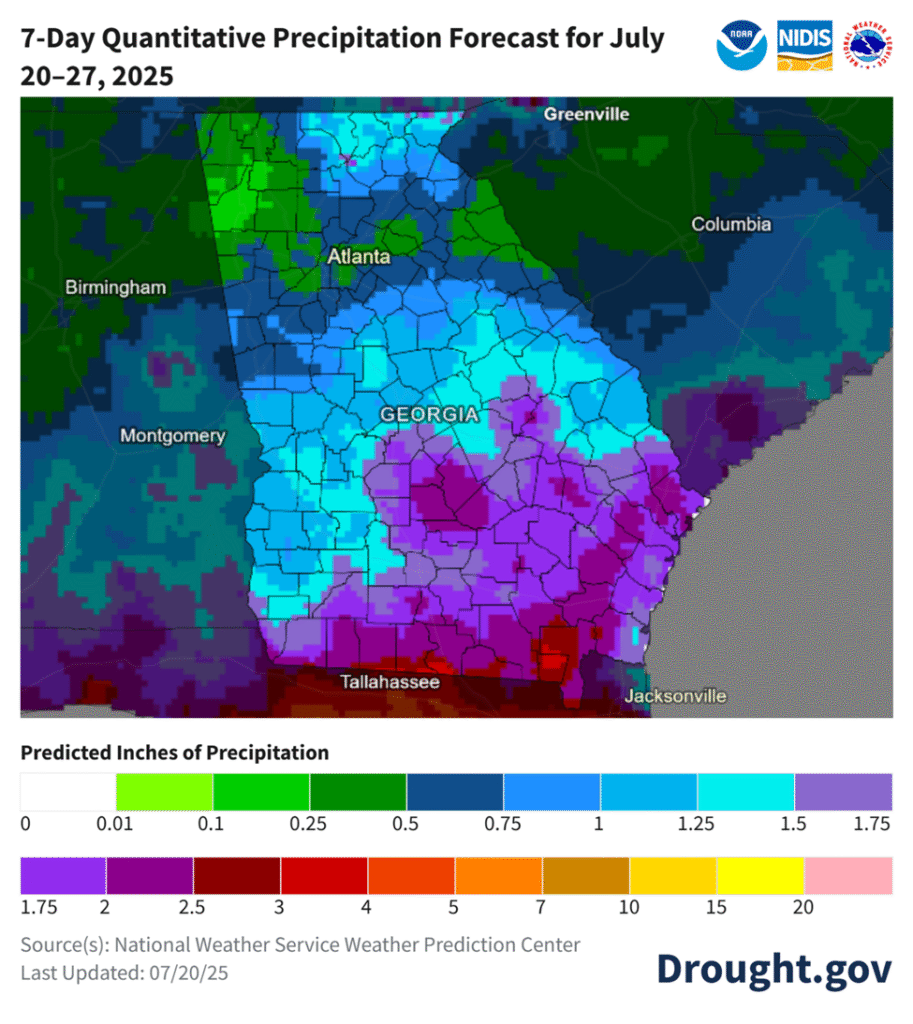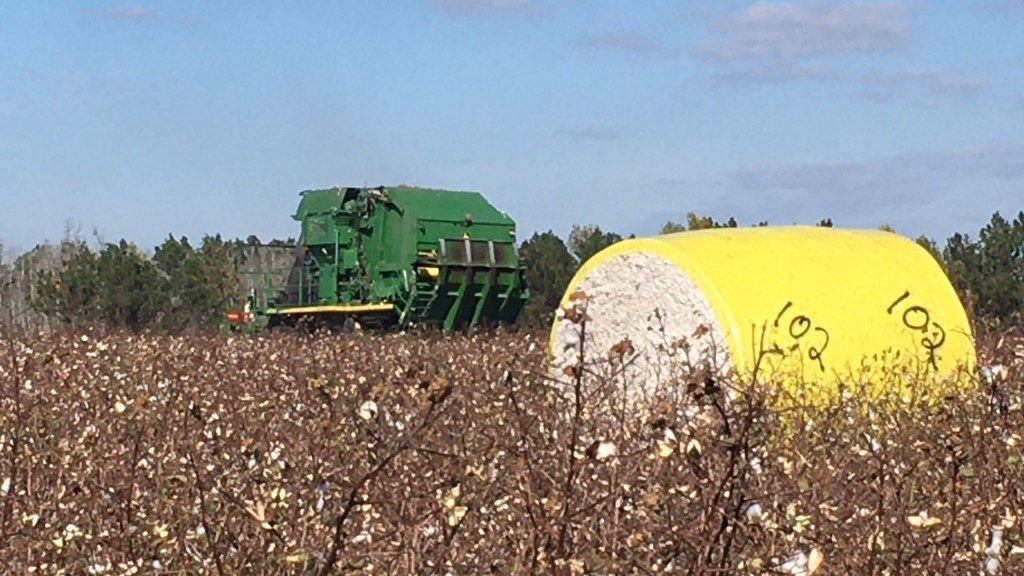Current Situation: This past week has been hot and there have been some hit-or-miss showers across the county. The majority of the corn crop is around or past dent stage. The cotton crop ranges from squaring to the 4th week of bloom. The peanut crop ranges from 30 to 90 days old. Insect pressure has been low in peanuts. Questions about plant and stink bugs have been common in cotton.
I had a few people make comments about how hot it was last week. The illustration below is the departure from the Normal Average Max Temperature for last week from the High Plains Regional Climate Center. It shows max temperatures were above average last week.

The illustration below shows the chances of rain increase this week, which will help with the irrigation efforts of local growers.

The crop progress report from this past week shows that the 55% of the Georgia cotton crop and 57% of the Georgia peanut crop is in good condition.

I had a question about the water requirements for peanuts. According to Dr. Porter, “Once peanuts begin blooming and pegging, they will use roughly 0.2” of water daily for ~20 days. By the middle of July, those early/mid-May planted peanuts can use up to 0.3” of water per day on days that it is hot, windy, with low humidity, so it is important to not get behind on irrigation. It is also important to not let your soil temperature get too high with peanuts pegging as high soil temperatures can burn off pegs. Even though it feels like we are still early in the crop season, peanut will hit peak water usage during July, so do your best not to fall behind and lose yield, especially if we continue to remain in similar weather conditions as we have through the middle of June. I think it is important to note that the soil water holding capacity of most of our sandy loam soils falls in the range of 1.0 inches per foot of soil with 50% of that being plant available. Thus, even with a two foot rooting depth, you will only have 1.0 inches of water available to the crop and that will be utilized in three days at the rate of 0.3 inch usage per day.
Please refer to the graph below to indicate where you are at with weekly water use in your peanut crop. Remember this requirement is IRRIGATION and RAINFALL with historical evapotranspiration rates figured into the equation. Due to years of research, peanut water demands during different stages have been identified but one of the variables in irrigation scheduling is ET rates. A free tool is available to help determine how much water is lost daily to evapotranspiration, the UGA Weather stations.
The ET values from the Moultrie site of the UGA Weather Network range from 0.19 to .27 inches per day for the period of July 13-19, 2025.


What about cotton irrigation? The graph below should give you a good idea of your weekly water requirements through the month of July IF you planted between mid-April and mid-May. If you planted later keep in mind that the Checkbook was developed from an estimated May 1 planting date, thus, you will need to adjust for higher temperatures and ET rates and will require on average more irrigation than represented in the Checkbook, especially if it remains hot and dry.

Over the last couple of weeks, I have received numerous questions about pgr applications (Kudos) on peanuts. Below, Dr. Monfort has some points to think about plant growth regulator use on peanuts.
My Take: Follow the plant’s actual growth—not the calendar. In some fields, expected at 65 days, vegetative development has lagged despite ample rainfall. This reinforces that timing decisions should be based on observed vine growth, not just days after planting.
Growth Regulator Timing & Rate Recommendations
If you planted peanuts in late April to early May, the first application should ideally have been initiated by now (75–80 days). Delayed application may reduce the regulator’s effectiveness.
Recommended application guidelines for runner peanuts:
• Rate Range: 3.5–5.4 oz/acre, applied twice
• Trigger: When 90% of vines are lapped (≥50% lateral vines touching in row middles)
• Second Application: 14–21 days after the first
• Avoid: 7.25 oz/acre applied twice—this rate is excessive for runner types
Total seasonal application should not exceed 11–11.5 oz/acre, as higher rates may cause plant stress and reduce yields.
Field-Specific Adjustments & Cautions
- Irrigated Fields
• Use growth regulator only if you have a history of aggressive vine growth or are growing vigorous varieties like GA-12Y or TIFNV-HG.
• Avoid spraying during hot, dry spells (90°F+ with no expected rain). High temps and regulator use together may over stress plants.
- Wait until the weather moderates.
- Apply irrigation 1–2 days prior to spraying.

Non-Irrigated Fields
• Generally, not recommended—but if conditions are excessively wet:
- Consider 1 application at 7.25 oz/acre (between 60–75 days)
- Avoid two applications unless rains continue steadily; dry, hot conditions after a second spray can severely impact yields.
Below is a great article from Mississippi State on the subject of rainfastness of insecticides.
Insecticide Rainfastness | Mississippi Crop Situation
Corn: Dr. Nick Shay, UGA Small Grains Agronomist, shows his athletic ability in the latest installment of the Two Minute Tuesday YouTube video. The topic is irrigation termination.
This was an interesting article by Mississippi State Small Grain Agronomist, Erik Larson on the reasons why kernels near the tips of the ears do not fil out.
Why did the Kernels near the Ear Tip not Fill? | Mississippi Crop Situation
Up Coming Events

2025 C. M. Stripling Irrigation Research Park Biennial Field Day – July 24
Growers and other interested parties are invited to come out the the research park on Thursday, July 24, and see the latest irrigation research to help growers with best irrigation management practices. The day will begin with registration at 8:00 a.m. and the welcome at 8:30. Field tours will be at 9:00 and 11:00 a.m. Dr. Nick Place, Dean of the UGA College of Agriculture and Natural Resources will be the keynote speaker at 10:00 a.m. The program will conclude with lunch and visiting with the sponsors.
See the article and agenda details from Dr. Wes Porter in the Extension Precision Ag and Irrigation blog: C. M. Stripling Irrigation Research Park Biennial Field Day | Extension Precision Ag and Irrigation
Have a safe week and if you have questions please call the office,
Jeremy M. Kichler
Colquitt County Extension Coordinator
The University of Georgia Cooperative Extension does not endorse or guarantee the performance of any products mentioned in this update.
